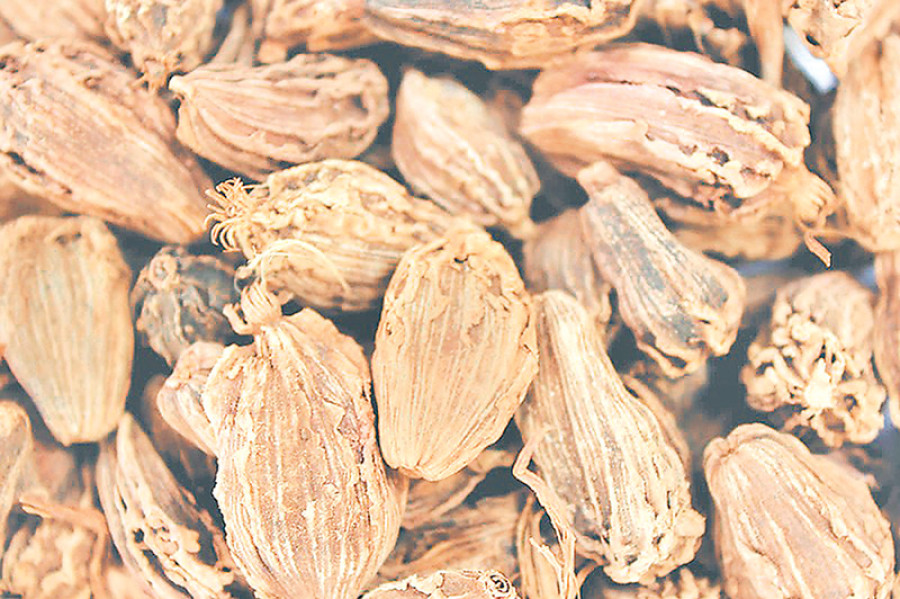Opinion
The spice of life
Large cardamom is an important source of livelihood for rural people in the mid-hills
Dharmendra Kalauni
For the mountain people living in Nepal’s eastern Himalayan region, the term ‘black gold’ is famously used to refer to large cardamom (Amomum subulatum Roxb). It is also known as the ‘queen of spices’. Large cardamom is the most prominent cash crop attracting high revenues, and it is an important source of livelihood for rural people in the mid-hills. The plant was introduced into Nepal from India in 1865. Commercial cultivation started only in 1953 in Ilam district. The Cardamom Development Centre was established in Pandam, Ilam in 1975 to expand the large c
ardamom acreage.
Currently, large cardamom is grown in 53 districts of Nepal. About 84 percent of the cardamom harvest comes from the eastern region, including Ilam, Taplejung, Sankhuwasabha, Dhankuta, Bhojpur, Tehrathum and Panchthar districts. Almost 70,000 farmers depend directly or indirectly on large cardamom for their livelihood. Large cardamom provides good returns compared to cereal crops like rice and wheat.
Export potential
The Nepal Trade Integration Strategy has recognised large cardamom as the most important agricultural
commodity with export potential. The Agriculture Development Strategy (2015-35) has prioritised it as a
high value, low volume cash crop. Cash crops like large cardamom also play an important role in
eradicating poverty and improving the livelihoods of rural people. But it’s unfortunate for our country not to have any specific government policy to promote its cultivation and trade.
Nepal is one of the leading producers of large cardamom in the world. About 90 percent of the large cardamom produced in Nepal is exported to India through Birtamod, Jhapa. The price of Nepal’s cardamom mostly depends on Indian markets, and the variability in prices is a serious problem for growers. Another problem is that productivity in Nepal is far below average. In India, productivity is around 2,000 kg per hectare while in Nepal it is only around 500 kg per hectare. The major reasons behind the low productivity are lack of scientific breeding activities to develop improved cardamom varieties and disregard for improved cardamom cultivation
practices by farmers.
Also, farmers are not aware about site specific nutrient management which leads to poor yields. In many places, farmers are growing cardamom in outdated orchards that are more than 40 years old. Such obsolete cardamom orchards are more prone to pest and disease, and have low productivity; therefore, renovation is a must in such orchards.
Another big challenge for farmers is disease and pest infestation in cardamom orchards. Farmers should be aware about proper practices from the nursery stage to the planting of seedlings. Nurseries should be established 500 metres from the cardamom orchard, and farmers must use pest exclusion nets in the nursery to keep away insects like aphids which transmit disease like Chirkye and Furkey from infected plants to healthy plants. The government and the private sector must take the initiative to produce disease-free seedlings using tissue culture technology to fulfil the demand for healthy large cardamom seedlings.
Value addition improves the quality of our products and brings us more money. Currently, Nepali farmers only cure large cardamom after the harvest. But they can add value to harvested large cardamom by adopting post-harvest practices like tail (calyx) cutting, removing inert matters, grading and polishing. Most farmers are still using traditional ways to dry large cardamom capsules. When large cardamom is dried in traditional ovens, the result is a drop in quality because of loss of the original red or purple colour, presence of smoky odour, over-drying of the
capsule, and loss in the chemical composition of the seeds inside.
Consequently, the cardamom will not meet contemporary market requirements, resulting in lower prices to farmers. A number of improved drying systems such as electric drying, double drum drying and smokeless wood combustor have been developed which yield better quality cardamom which retains its own natural red or purple colour. Farmers should adopt value addition practices in a standard way to gain competitive market opportunities in a growing market arena.
Auction facilities
Large cardamom producers receive low prices and are compelled to sell their products at prices set by local wholesalers due to lack of auction facilities. A few years ago, farmers were receiving up to Rs2,500 per kg for their cardamom, but now they get only Rs700 per kg. In this scenario, the government’s role in protecting profits for farmers will be an important aspect in large cardamom trading. Despite the big export prospects, more work needs to be done to enhance trade. Both the government and the private sector must realise the importance of proactively seeking new mar¬ket opportunities and maximising our export potential. There is a clear need to focus on improving production and achieving greater market pen¬etration and diversification.
Kalauni is an agriculture student at the Agriculture and Forestry University, Chitwan.




 18.12°C Kathmandu
18.12°C Kathmandu










